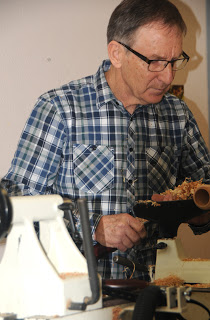Workshop Report February 2018
Our two demonstrators for February were Peter Manning and Ger Hennessy both very experienced and talented demonstrators.
On Feb 17th we returned to our base at the Old School Togher. Peter was first up and demonstrated until the tea break and Ger then followed full of energy after the coffee cakes and biscuits, supplied as usual by John O Shea.
Peters demo was very suitable both for the beginner looking for a challenge and also someone with more experience. He immediately ran through what he had prepared; a Spanish lady, a Ballycotton duck/swan and a Christmas tree. Ornamental tree making is obviously very popular around Christmas so you can be planning already.
Peter began with the Spanish lady by explaining the setting out ( 3 centres on the base, 3/8 inch or 10mm either side of true centre) he then passed around one already made for close inspection.As usual Peter fielded many questions in his calm and encouraging way. During the demo he stressed several times the importance of enjoyment, trying new ideas and mostly of having fun with your woodturning.
Peter then proceeded with his second project, his duck, which was a similar process,(off centre turning) to the lady so he was able to move along without too much repetition.
For his final project Peter took a waste piece of branch wood between centres and turned a tree that did not require any sanding and the final decoration was left to your own imagination. He also spoke on the importance of using the skew chisel, mainly because of the finer finish and the less amount of sanding required.
Peter touched on some of the main points again before finishing (see below)
1. No pressure on the tailstock end - support only.
2. Ramp up speed for off centre work - for something small it would be fine at c1200rpm but you must be in your comfort zone -
if you are not comfortable with the speed turn it down.
3. Have fun! Peter says, and we all have to agree.
Next up saw Ger Hennessy all ready for action, having enjoyed his coffee and ???????, his demo piece was a cocktail stick dispenser again with the beginner in mind but still with plenty of scope for enhancements, that would appeal to the more experienced, e.g. texturing, chatter work, pyrography
colour etc. Ger provided a large drawing which he hung on the wall ,to help explain the different stages involved, and was able to explain and make simple what appeared to be a complex piece, He also distributed a handout for the beginners, but I think that he saw me and a few of the cute old hands slipping one into our pockets. Ger being the gentleman that he is ignored such carry-on.
Anyway as always Ger went through each methodically starting at the bottom, then the inner cup, to the dowel and finally the lid. When fitted together it worked as smooth as a precision piston.
Some tips along the way:
1 Sharpen the fostner bit regularly as they are made from hardened high carbon stee
2 Slow down the lathe to a snails pace when drilling- prevents damage to the bit and timber
3 When making more than one work from a drawing or sketch with measurements
Both demonstrators gave clear and concise explanations for all stages and techniques. It was obvious
they stuck to a well planed schedule and as a result we finished on time and ..As always a Workshop Report will never replace the real thing-the actual demonstration.
I would like to thank Kevin Geaney for providing the prizes for the competition, Kevin won the beginners section but was missing for the photos. I would also like to thank all those who open and prepare the school, set up the lathe, cleaning up, help around the lathe, cameras, safety officer for the demos, look after the library,purchasing tea coffee etc.and making the tea and coffee,and always cleans the kitchen, judges, competition score keepers, and anyone who helps in any way, sorry to anyone if I did not mention your help but I can assure you that you are greatly appreciated .
It always seems to be the same people who clean the demo room, the kitchen, and put away the lathe etc, so I am asking everyone to help, after all we all participate and enjoy the demonstrations so please do not leave it to the few.
John B Ahern Chairman












